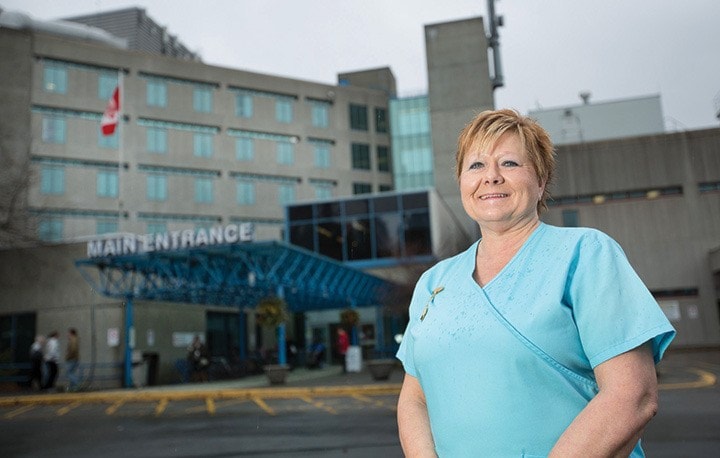Last in a three-part series examining proposed changes to acute care nursing in Greater Victoria hospitals.
The B.C. Nurses’ Union and Island Health are locked in a bitter dispute about changing the model of nursing, but one health care professional has seen the new system work successfully at Victoria General Hospital.
Mary Ann Desjardins, a care aide for 21 years, is stationed at the VGH neuroscience department and works with a team of two registered nurses and one licensed practical nurse. The team normally cares for about 14 patients, and Desjardins helps them eat, get in and out of bed, bathe and use the toilet.
“We’re able to do the extra little pieces that a registered nurse doesn’t have time to do, such as comforting the patient,” she said. “There are times when I look at a patient and decide, ‘I’m going to sit with this person because I know he or she is frightened.’”
Her team was part of a small pilot project for the care delivery model redesign implemented in acute care at Nanaimo Regional General Hospital in September and planned for Victoria General and Royal Jubilee hospitals in April.
Changes would have care aides take on the duties of feeding, bathing and toileting acute-care patients in an effort to reduce costs and give patients more one-on-one time with a health-care professional.
Desjardins said having care aides in acute care is a positive change. “(The proposed model) can lighten the load for nurses. I know it’s a good thing, I’ve seen it work.”
BCNU wants the model scrapped, arguing that it decreases, and in some cases eliminates, direct patient time with nurses. It also said care aides don’t have the same education to notice subtle changes in a patient’s health, which could be life threatening.
Desjardins disagrees saying that care aides have adequate training in patient observation.
“That is our main focus because before being brought into acute care, (care aids) were mostly in residential care. Nurses (in residential care) totally depend on us,” she said.
Yet the proposed model is provoking worry across all units at Victoria General, including Desjardins,’ due to negative stories emerging out of Nanaimo and a lack of details from Island Health, she said.
“We don’t know what it’s going to look like. It creates a bit of frustration.”
The Hospital Employees Union, which represents health-care assistants, says its members are upset that their skills are being questioned, as they are trained professionals who work within their mandate, which includes noticing subtle changes in patients.
“It’s disheartening to hear people feel they have to advance their own interest by diminishing the role others provide,” said HEU secretary business manager Bonnie Pearson.
“We should be part of the care team. We are at the patient’s bedside often where we see changes in a person’s health.”
In Alberta, the union representing nurses is fighting a similar battle as the BCNU, as care aides there have assumed the same tasks that Island Health is trying to implement.
The United Nurses of Alberta is also accusing Alberta Health Services of replacing nurses with care aides, and that union claims it has evidence proving Alberta “plans to eliminate hundreds of nursing jobs.”
The BCNU also asserts the care delivery model redesign is about replacing nurses with lower-cost care aides. The union fears the change will eventually be adopted by other health authorities across B.C.
Rita den Otter, executive leader for the initiative for Island Health, said using care aides in hospitals and in acute-care wards is nothing new.
The system was introduced to smaller Island hospitals such as Cowichan, Campbell River and West Coast General in Port Alberni several years ago, and care aides work in acute care wards in other parts of Canada, the United States and in Europe.
The care model will ease a nurse’s workload and will not result in job losses, den Otter said.
“We all live on the Island, too, and our families come to our hospital for care,” she said. “When we redesign patient care, we are thinking of our own family as well. We try very hard, always to provide the best possible care we can and show that it’s safe to come to our hospital.”
reporter@vicnews.com
Previously in this series:
Nursing series: Part 2 - Acute care in critical condition on Vancouver Island
Nursing series: Part 1: New Vancouver Island model will hurt patient care, BCNU says
